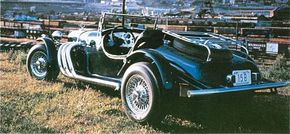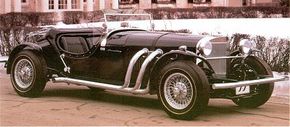Many "replicars" have come and gone since the mid-1960s, so it's fitting that the first and best of the breed -- the 1965-1969 Excalibur Series I -- would survive the longest. It was the splendid creation of noted industrial designer Brooks Stevens.
Advertisement
The first Excaliburs were lightweight race-and-ride roadsters built in 1951 with "vintage-modern" bodywork on the Henry J chassis, but the production Excalibur was born in 1963 at Studebaker, where Stevens had been a consultant the previous four years.
Having completed clever, low-cost face-lifts on the compact Lark and sporty Hawk coupe, he was asked by company president Sherwood Egbert to come up with some show cars to convince people that moribund Studebaker had a future after all.
At first, time permitted only a trio of dolled-up Larks. But for the annual New York Auto Show in April 1964, Stevens wanted something that would really "get people to come to that damn booth." Egbert, sadly, was stricken with cancer by then, but successor Byers Burlingame agreed to go along.
Stevens devised what he called a "contemporary classic," a new car that looked like the supercharged Mercedes SSK he once owned. Badged "Studebaker SS," the dashing cycle-fendered roadster, riding a Lark Daytona convertible chassis with supercharged, 290-horsepower 289 V-8, was completed in just six weeks by Stevens and his sons David and William.
No sooner did it arrive in New York than Studebaker backed out, officials saying it was at odds with their new "common sense" theme. Undeterred, Stevens exhibited the SS on his own, and immediately drew an avalanche of orders.
This prompted his sons to form SS Automobiles in August 1965, and within a year they'd built 56 examples of a modified SS bearing the Stevens-registered name Excalibur -- and "sword-in-circle" radiator mascot that suggested, but didn't infringe upon, Mercedes' jealously guarded tristar emblem.
Studebaker, meantime, had ceased production, but the Stevens brothers secured 300-bhp 327 V-8s from Chevrolet that gave their lithe, 2,100-pound Excalibur exhilarating performance. With standard 3.31:1 rear axle, 0-60 mph took less than five seconds, versus seven for the Studebaker-powered prototype. And projected top speed was near 160 mph!
Continue reading to learn more about the 1965-1969 Excalibur Series I.
For more information on cars, see:
- Classic Cars
- Muscle Cars
- Sports Cars
- Consumer Guide New Car Search
- Consumer Guide Used Car Search
Advertisement


